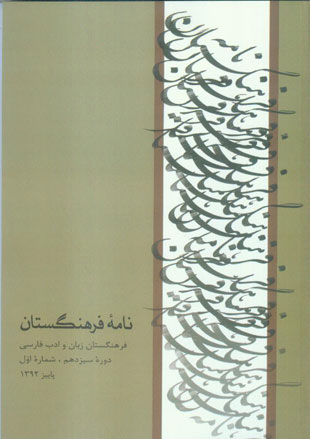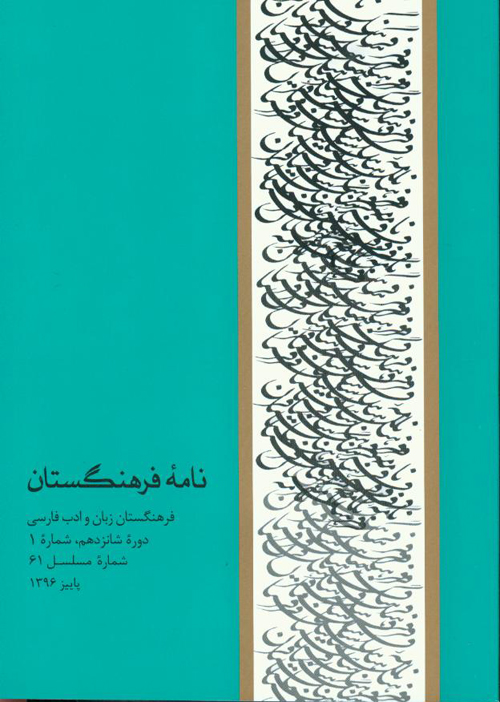فهرست مطالب

نامه فرهنگستان
سال سیزدهم شماره 1 (اردیبهشت 1392)
- ویژه نامه فرهنگ نویسی (5-6)
- تاریخ انتشار: 1392/03/07
- تعداد عناوین: 33
-
- سرمقاله
-
تشدید در زبان فارسیصفحات 3-43
- مقاله
-
صفحات 44-65
-
صفحات 66-74
-
صفحات 75-92
-
صفحات 93-104
-
صفحات 105-118
-
صفحات 131-135
-
صفحات 136-151
- نقد و بررسی
-
صفحات 152-173
-
صفحات 174-195
-
صفحات 196-205
- پژوهش های لغوی
-
صفحات 206-222
-
صفحات 223-244
-
صفحات 245-270
-
صفحات 271-295
-
صفحات 296-301
-
صفحات 302-308
-
صفحات 309-322
-
صفحات 323-328
-
صفحات 329-333
-
صفحات 334-339
-
صفحات 340-350
-
صفحات 351-358
-
صفحات 359-365
- بازتاب
-
صفحات 368-369
-
صفحات 370-373
-
صفحات 374-375
- تازه های نشر
- اخبار
-
صفحات 386-388
-
صفحات 389-391
-
صفحات 392-400
-
Gemination in PersianPages 3-43There are a number of words with a geminated consonant in Persian. Historically, many of these geminates are the result of assimilation of two neighboring consonants with articulatory similarities. There are others, especially in poetry, which are connected with contexts in which a phonetically or phonologically historical long vowel precedes a consonant. Having been shortened, this long vowel causes the following consonant to become geminated. Unaware of the underlying causes of such gemination processes, classical specialists of prosody and rhetoric have recommended such geminated words to be avoided when possible. The present paper is an attempt to explicate the underlying causes of these geminations in Persian. Moreover, it deals with Arabic geminate borrowings and their evolution in Persian. Reference is finally made to the analogical type of gemination.
-
Pages 66-74Existing studies on the subject of lexicography tend to deal mainly with its technical aspects. Lexicography, however, enjoys the benefit of social bearing as well, a fact that should, nevertheless, not to be ignored. Topics such as the social function of dictionaries, the place of lexicography in language planning and the manner in which lexicographers deal with 4 Farhangnevisi 5 & 6 Summary of the Contents linguistic variation reflect a close association between lexicography and socio-linguistic issues. As a rule, it is essential to distinguish two kinds of linguistic methodology of approach: 1- descriptive method that reveals fundamental and for the most part unconscious patterns of language; 2- prescriptive method that determines which linguistic features are precise and acceptable by the speakers of a given linguistic society. It seems that it is the latter method that is generally applied in lexicography as well as any endeavor dealing with compilation and stabilization of linguistic data, albeit most often in the process prescription tends to be exercised under the disguise of description. It is this symbolic function of dictionaries that grants them social authority next to their linguistic authority, that is, an authority for judgment on linguistic behavior (as part of social behavior) and a source of authentic linguistic patterns in the lexicon. Hence, dictionaries are believed to have a special function in corpus planning. But, on the other hand, the placement of lexicography solely in the category of corpus planning (language development) at the expense of status planning can be a measure open to question. For, status planning, that is, language determination, too, deservedly has an important place in lexicography. Language variability and linguistic variation stand in contrast to the function of dictionaries. Therefore, the lexicographers’ encounter with this dilemma is demanding. Whereas there is no easy solution to the problem, it is possible to provide a clear description of linguistic variation while complying with the basic function of dictionaries as the provision of standard patterns. The other option is to make special dictionaries for linguistic varieties.
-
Pages 75-92Criticizing and evaluating dictionaries are as important as their production. A barrier against enhancing knowledge among the public and their skills in 5 Farhangnevisi 5 & 6 Summary of the Contents using dictionaries is the non-existence of a comprehensive and integrated theory for criticizing and evaluating dictionaries, which has its own negative impacts on the production of comprehensive, efficient, and user-friendly dictionaries. Put differently, there is currently no one to mediate between the user and the compiler of a dictionary other than the dictionary itself. This leaves a gap that must be filled by a dictionary critic who is, by definition, in possession of the competence and skills required for the task. The present paper tries to provide procedures and suggestions for developing an efficient, enlightening, and scientific framework for evaluating dictionaries.
-
Pages 93-104According to the principles of dependency grammar, verbs are the central constituents in the structure of sentence, for they determine what complements are or can be used in it. The question is what lexical categories should be entered in a dictionary as verbs? This distinction becomes much more crucial when compound verbs are involved, especially in the Persian language in which compound verbs are abound and their exact definition is open to argument. Two Iranian grammarians, Mohammad Dabir Moqaddam and Alaaddin Tabatabai, have, notably, dealt with the issue. Dabir Moqaddam maintains that the process of forming a compound verb is twofold, compounding and incorporation. Now, one way of approaching the issue is to reverse the question and ask what strings are not to be taken as compound verbs.
-
Pages 105-118According to Ladislav Zgusta, the historical dictionary of a language, along with its etymological dictionary, is one of the two facets of its diachronic dictionary. In other words, to rephrase the definition asserted by Hartmann and James, a historical dictionary is a kind of reference source in which one can follow the stages of development of lexicon in a language at the level of form and meaning in the course of time. But one should also bear in mind that a historical dictionary, in addition, offers a thorough description of contemporary lexicon of the language. Thus, it may, in Osselton’s words, be called a ‘hybrid’ work. What may, potentially, pose a difficulty in making a historical dictionary are certain texts whose authors somehow deviate from the use of contemporary vocabulary of a language and employ elements from the vocabulary of earlier periods in different levels and with different intentions. To be sure, those texts that tend to archaism, do not, as a rule, reflect the natural course of development in the respective language. Therefore, from this point of view, such texts can not be trusted as evidence. As far as contemporary texts are concerned, it is not difficult to detect the deviation. In the case of non-contemporary texts, however, the circumstances may be somewhat complicated for those not well-informed relative to the stages of development in a given language in the course of time. A good case in example is Persian language and its contemporary and non-contemporary texts, and the way they should be put to use in making a historical dictionary.
-
Pages 131-135A book entitled Tāj-al-Masādir is cited by Haji Khalife in his encyclopedic book Kashf-al-ḏ͎unūn, attributed to Rūdakī Samarqandi. In fact, Haji Khalife cites two books of almost the same title by two authors: 1- Tāj-al-Masādir fi al-luγat by Abi Ja‘far Ahmad Ibn ‘Ali al-ma‘ruf bi Ja‘farak al-Muqri al- Bayhaqi, and 2- Tāj-al-Masādir fi luγāt al-Furs by Rūdakī al-Šā‘ir Abi al- Hasan Mohammad ibn [Abdillāh al-Samarqandi, al-mutavaffa sanat 434]. A number of contemporary scholars of Persian literature, among them Said Nafisi and Mohammad Dabir-Siyaqi, disputed the authenticity of Haji Khalife’s attribution. According to Nafisi, the last part of the latter’s name, shown here in bracket, is a later addition by the publisher of the second edition of Kashf-al-ḏ͎unun, for it is absent in the first edition of the book. Furthermore, this added part is totally erroneous: That Rūdakī’s name was Abu ‘Abdullāh Ja‘far ibn Mohammad and he died in the year 329/1002 is beyond dispute. In addition, there is no doubt that Haji Khalife’s ascription of the book entitled Tāj-al-Masādir fi luγat al-Furs to Rūdakī is incorrect, and the seemingly two books are in fact the same, its proper title being Tājal- Masādir fi al-luγat authored by above mentioned Abu Ja‘far Ahmad ibn ‘Ali al-ma‘ruf bi Ja‘farak al-Muqri al-Bayhaqi in the year 544/1147. The book is an Arabic-Persian dictionary of infinitives. Apparently, the close resemblance of two names, particularly the presence of the name Ja‘far in both, must have impelled someone to attribute the book to Rūdakī, and the author of Kashf-al-ḏ͎unūn cited his erroneous attribution without hesitation. Dabir-Siyaqi is of almost the same opinion as Nafisi, except that he believes that it is possible to have two books, the second simply entitled Tāj-al- Masādir, authored by one Abu al-Hasan Mohammad ibn ‘Abdillāh Samarqandi who died in 343/955. These opinions aside, it seems that there are other reasons for the incorrect attribution of Tāj-al-Masādir to Rūdakī. First, there is a book entitled Al-Masādir or the Tāj-al-Masādir authored by 8 Farhangnevisi 5 & 6 Summary of the Contents Zuzani the philologist (d. 485/1093). It is quite possible that as a consequence of misreading لزوزنی as لرودکی, the book ended up being attributed to the poet of Samanid court. Second, almost the entire content of Zuzani’s book was copied by Bu Ja‘farak Bayhaqi in his work. So, it is conceivable that the close identity of contents of the two books led to the incorrect attribution in question.
-
Pages 136-151There is a span of three centuries between the time Nāser-e Khosrow lived (5th/11th) and the date that appears in the earliest extant manuscript of his Divan (8th/14th). It seems self-evident that throughout these long centuries, as a result of numerous copying, so many errors, distortions and misspellings have found their way into the original text of his poetry. What, specially, may have aggravated the situation is his not so common choice of words, meters and grammatical patterns which, along with certain characteristics of his individual style, always made reading and comprehension of his poems more or less difficult for the readers and copyists alike. Therefore, one can hardly trust even the best critical editions of his Divan. Be that as it may, a number of literary scholars in the past few decades have come up with explanatory notes to, and emendations in, some of the problematical distiches of the Divan of Nāser-e Khosrow, a select list of which is presented in this article, in some cases with additional notes by the present author. Here are two examples: نه کفتاري “” for “بگفتاري” in the following distich: تو همی بینی کت پاي همی بندد پس چرا خامشی و خیره بگفتاريپشین “” for “بشیر” in the following distiche: استاده بدي به بامیان شیري بنشسته به عز در بشین شاري


